Overview
Nonalcoholic fatty liver disease
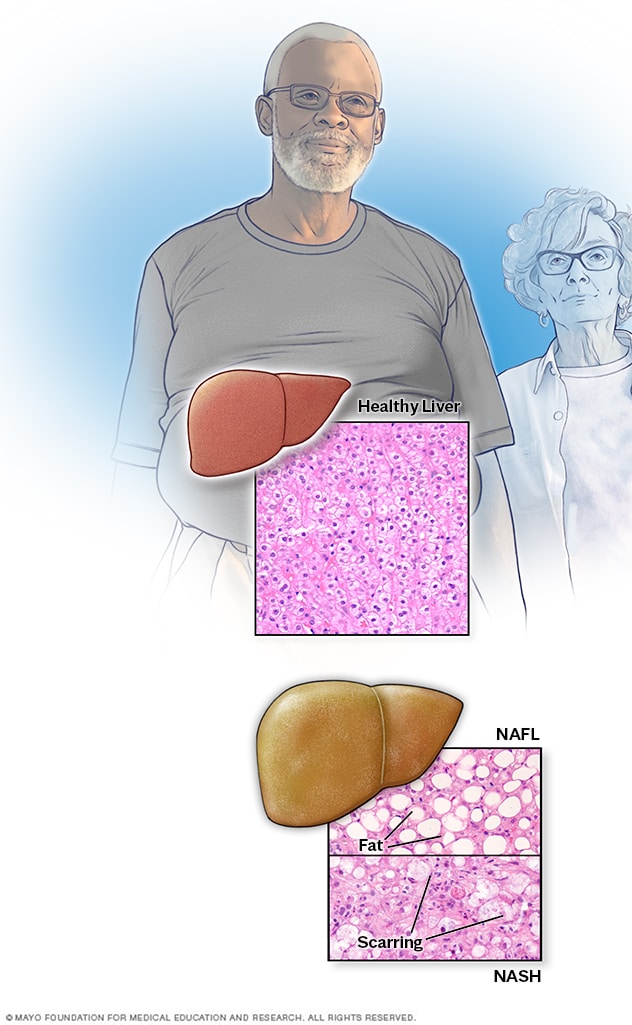
Nonalcoholic fatty liver disease
Compared with a normal liver ( left ), a fatso liver ( correct ) appears elaborate and discolor. weave samples reveal fat deposits in nonalcoholic fatty liver disease, while excitement and advance scar ( cirrhosis ) are visible in nonalcoholic steatohepatitis .
Nonalcoholic fatty liver-colored disease ( NAFLD ) is an umbrella term for a range of liver conditions affecting people who drink fiddling to no alcohol. As the mention implies, the main characteristic of NAFLD is excessively much fat stored in liver cells.
NAFLD is increasingly common around the earth, particularly in westerly nations. In the United States, it is the most common shape of chronic liver disease, affecting about one-fourth of the population .
Some individuals with NAFLD can develop nonalcoholic steatohepatitis ( NASH ), an aggressive mannequin of fatty liver-colored disease, which is marked by liver inflammation and may progress to advanced scar ( cirrhosis ) and liver-colored failure. This damage is similar to the damage caused by fleshy alcohol use .
Symptoms
The liver
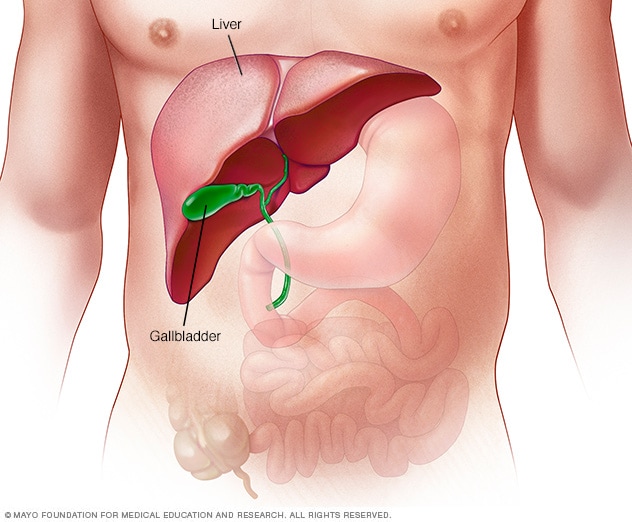
The liver
The liver is your largest internal organ. About the size of a football, it ‘s located chiefly in the upper right part of your abdomen, beneath the diaphragm and above your stomach .
NAFLD normally causes no signs and symptoms. When it does, they may include :
- Fatigue
- Pain or discomfort in the upper right abdomen
potential signs and symptoms of NASH and advanced scar ( cirrhosis ) include :
- Abdominal swelling (ascites)
- Enlarged blood vessels just beneath the skin’s surface
- Enlarged spleen
- Red palms
- Yellowing of the skin and eyes (jaundice)
When to see a doctor
Make an appointee with your doctor of the church if you have haunting signs and symptoms that cause you concern .
There is a trouble with data submitted for this request. Review/update the information highlighted below and resubmit the kind .
Get the latest health information from Mayo Clinic delivered to your inbox.
Subscribe for barren and receive your in-depth guide to digestive health, plus the latest on health innovations and news program. You can unsubscribe at any time .
Email address
ErrorEmail field is required
ErrorInclude a valid electronic mail address
First Name (let us know your preferred name)
Last Name
To provide you with the most relevant and helpful information, and understand which information is beneficial, we may combine your e-mail and web site use information with other information we have about you. If you are a Mayo Clinic patient, this could include protected health information. If we combine this data with your protected health information, we will treat all of that information as protect health information and will only use or disclose that data as plant forth in our notice of privacy practices. You may opt-out of electronic mail communications at any time by clicking on the unsubscribe yoke in the electronic mail .
Thank you for subscribing
Your in-depth digestive health usher will be in your inbox soon. You will besides receive emails from Mayo Clinic on the latest health news program, research, and worry .
If you don ’ metric ton receive our electronic mail within 5 minutes, check your SPAM booklet, then contact us at newsletters @ mayoclinic.com.
Read more: Simple Secrets To Weight Loss
Sorry something went wrong with your subscription
Please, test again in a couple of minutes
Causes
Experts do n’t know precisely why some people accumulate fat in the liver while others do not. similarly, there is circumscribed understanding of why some fatso livers develop inflammation that progresses to cirrhosis .
NAFLD and NASH are both linked to the play along :
- Overweight or obesity
- Insulin resistance, in which your cells don’t take up sugar in response to the hormone insulin
- High blood sugar (hyperglycemia), indicating prediabetes or type 2 diabetes
- High levels of fats, particularly triglycerides, in the blood
These combined health problems appear to promote the deposit of fat in the liver. For some people, this surfeit fat acts as a toxin to liver cells, causing liver-colored excitement and NASH, which may lead to a buildup of scratch tissue in the liver .
Risk factors
A wide scope of diseases and conditions can increase your hazard of NAFLD, including :
- High cholesterol
- High levels of triglycerides in the blood
- Metabolic syndrome
- Obesity, particularly when fat is concentrated in the abdomen
- Polycystic ovary syndrome
- Sleep apnea
- Type 2 diabetes
- Underactive thyroid (hypothyroidism)
- Underactive pituitary gland (hypopituitarism)
NASH is more likely in these groups :
- Older people
- People with diabetes
- People with body fat concentrated in the abdomen
It is difficult to distinguish NAFLD from NASH without far screen .
Complications
Normal liver vs. liver cirrhosis
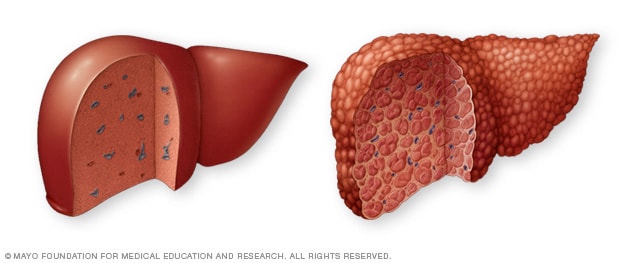
Normal liver vs. liver cirrhosis
A normal liver ( left ) shows no signs of scarring. In cirrhosis ( right ), scar weave replaces normal liver tissue .
Esophageal varices
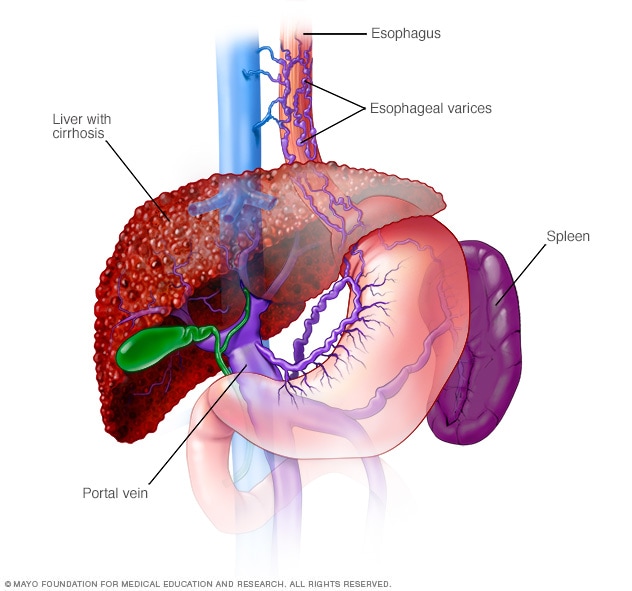
Esophageal varices
esophageal varices are hypertrophied veins in the esophagus. They ‘re frequently ascribable to obstructed blood flow through the portal site vein, which carries blood from the intestine, pancreas and irascibility to the liver .
Liver cancer
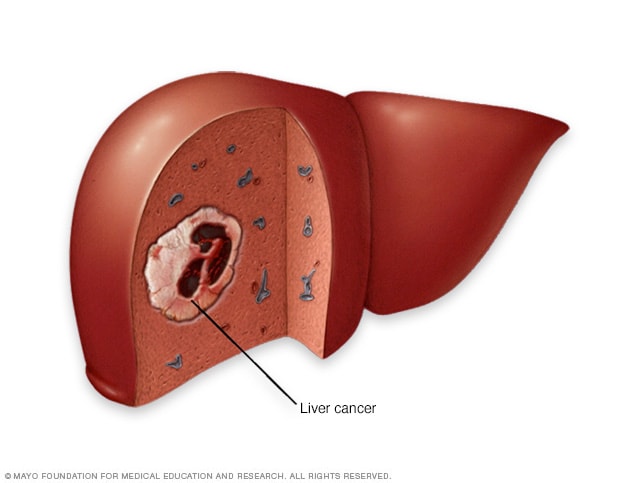
Liver cancer
Liver cancer begins in the cells of the liver. The most common form of liver cancer begins in cells called hepatocytes and is called hepatocellular carcinoma .
The main complication of NAFLD and NASH is cirrhosis, which is late-stage scarring in the liver. cirrhosis occurs in response to liver injury, such as the ignition in NASH. As the liver tries to halt ignition, it produces areas of scar ( fibrosis ). With continue ignition, fibrosis spreads to take up more and more liver weave .
If the process is n’t interrupted, cirrhosis can lead to :
- Fluid buildup in the abdomen (ascites)
- Swelling of veins in your esophagus (esophageal varices), which can rupture and bleed
- Confusion, drowsiness and slurred speech (hepatic encephalopathy)
- Liver cancer
- End-stage liver failure, which means the liver has stopped functioning
between 5 % and 12 % of people with NASH will progress to cirrhosis.
Prevention
To reduce your risk of NAFLD :
- Choose a healthy diet. Choose a healthy plant-based diet that’s rich in fruits, vegetables, whole grains and healthy fats.
- Maintain a healthy weight. If you are overweight or obese, reduce the number of calories you eat each day and get more exercise. If you have a healthy weight, work to maintain it by choosing a healthy diet and exercising.
- Exercise. Exercise most days of the week. Get an OK from your doctor first if you haven’t been exercising regularly.